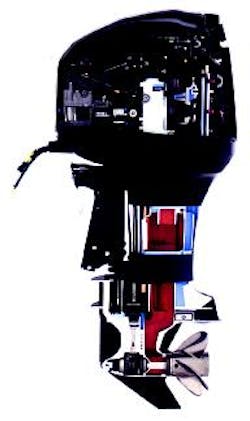Cells propel marine motor production
Using six Palletech cells from Mazak, Mercury Marine machines blocks, heads, and gear cases for its OptiMax family of outboard engines.
Machining technology and its deployment was a primary constraint on Mercury Marine's ability to create and deliver its OptiMax line of outboard motors. To overcome this obstacle, the Fond du Lac, Wis., company worked with Mazak to incorporate six HMC cells for machining motor blocks, heads, and gear cases.
Engineers from both companies collaborated on installing Palletech cells, each containing seven or eight FH-680 horizontal machining centers fitted with 120-station tool magazines. "For efficiency's sake, we wanted to link machines together into cells rather than use them as standalone units," says Leo Santini, vice president of corporate manufacturing at Mercury.
The setup gives the company flexibility for managing volume through all of its lines. Because tools and programs are resident at every machine, each cell can produce more than one type of part in random order. In fact, one cell makes more than 30 versions of cylinder blocks and heads.
The cell controller reads the tag on an incoming pallet containing a fresh casting and tells the next available machine which job to execute.
Juggling volume among the cells is possible because any part can run in any cell if the need to reapportion production ever arises. The only difference among cells is that some have seven machines instead of eight, but they are all identically configured. Each machine, for example, has the same 120-station tool magazine, even though none are full. "We fill 100 tool stations on some machines and 60 on others," says Jeff Smith, director of manufacturing engineering teams at Mercury. "We wanted the ability to reconfigure the machines should the need arise."
The only adaptation necessary to prepare a cell for running a new job, therefore, is loading the appropriate tools, entering programs into the cell controller, and putting pallets fitted with the required fixtures in queue. The cell controller then pulls the correct pallet from a parking lot, tracks it through the cell, and, afterwards, stations it until needed.
Generally, the first cell makes gear cases, the second cell machines both blocks and cylinder heads for various two-stroke engines, and the third and fourth do larger engines. The third cell performs qualifying operations on the blocks, and the fourth cell finishes them and machines the cylinder heads. The fifth cell produces blocks for smaller four-stroke and two-stroke (6 to 15-hp) engines.
Mercury does special operations not suited for machining centers — such as line boring, liner pressing, cylinder boring, final deburring, and washing — next to the cells. This allows parts coming from the cells to flow seamlessly into these special lines.
Parallel production is another strategic practice that gives the six Palletech cells flexibility. Manufacturing engineers at Mazak and Mercury developed the fixtures and processes so that the machines in each cell perform as many operations as possible with the least amount of clampings. Each machining center completes all operations for a given clamping, rather than executing a short sequence of operations and passing it to the next machine. Not having to plan such sequential operations simplifies handling a variety of parts and moving production among cells.
Mazak Corp.
Florence, Ky.
www.mazak.com
